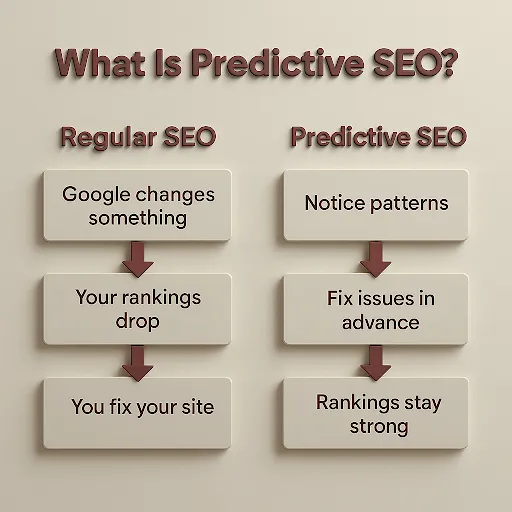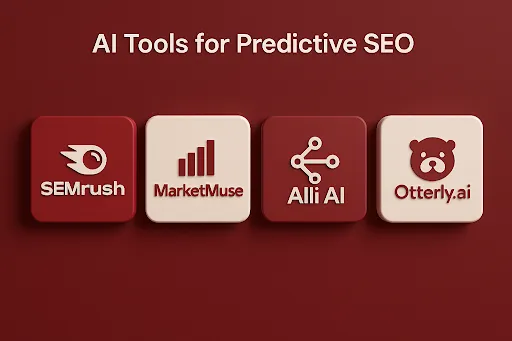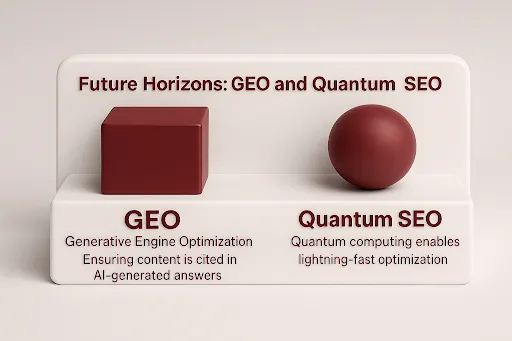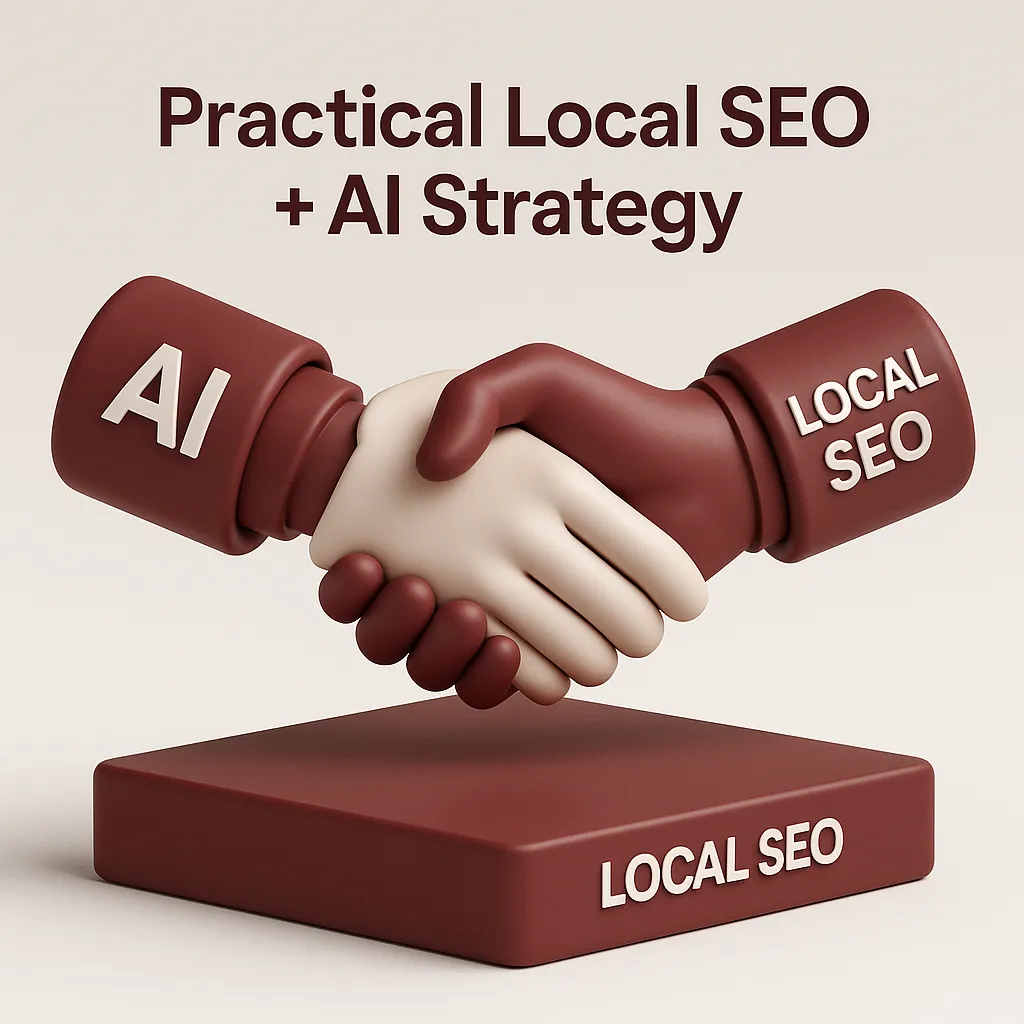Conventional SEO frequently involved waiting, rushing, and restoring lost rankings in response to Google updates. However, that strategy is no longer sufficient. Here comes Predictive SEO, which moves the emphasis from response to preparation by using AI to predict algorithms. Businesses can use AI-driven insights to predict search trends, spot early indicators of algorithm changes, and optimize strategies ahead of time rather than chasing after changes.
Even in unstable search environments, this proactive approach guarantees stability, protects rankings, and optimizes performance. The objective of predictive SEO is straightforward: make future-ready, well-informed SEO decisions to stay ahead of the competition, not to catch up.
What Is Predictive SEO?
To predict future changes in rankings, predictive SEO uses a combination of trend analysis, machine learning models, and historical data. You anticipate changes and make preemptive adjustments to your strategy rather than reacting after an algorithm rollout.
For instance, content opportunity analysis and traffic trend forecasts are now available through tools like MarketMuse and SEMrush’s Position Tracking. Companies that use these insights see improved ROI and more consistent ranking performance.

Why Predictive SEO Matters Now
The search landscape is changing more quickly than before. According to recent research, even as visibility increases, AI Overviews are decreasing click-throughs by over 30%. This indicates that while impressions are increasing, traffic isn’t.
The frequency and disruption of algorithm updates have increased. Google released two major core updates in 2025 alone, in March and June, with weeks-long volatility.
Reactive tactics are no longer effective. To stay ahead of the competition and maintain visibility, businesses require predictive tools and procedures.
AI Tools for Predictive SEO
Businesses’ approaches to search optimization are changing as a result of AI-powered platforms. These tools accurately predict algorithm shifts, analyze large datasets, and identify early ranking signals. Through their use, marketers can protect visibility, proactively improve strategies, and predict changes—ensuring long-term stability in an unpredictable search landscape.
The following are the best tools for using SEO’s predictive capabilities:
- SEMrush helps prioritize high-opportunity terms by forecasting traffic potential and rankings for tracked keywords.
- MarketMuse is perfect for extensive content planning since it employs predictive modeling to find content gaps and changes in user intent.
- By examining the competitive environment, algorithm changes, and content performance, Alli AI provides machine-learned forecasting.
- Otterly.ai: Provides insights into generative search discoverability by tracking how AI systems mention or feature your brand.

Techniques for Predictive SEO
In order to predict algorithm changes, forecast keyword trends, and spot new search behaviors, predictive SEO strategies make use of AI and data models. Proactively modifying content, metadata, and site structure helps businesses stay resilient, hold onto their rankings, and take advantage of early traffic opportunities.
a) Project traffic patterns
To predict where rankings and traffic might move in the coming weeks or months, use tools that have historical performance and CTR data.
b) Track the volatility of rankings
Keep an eye out for early indicators that may portend future updates, such as abrupt drops in CTR or shifts in competitor rankings.
c) Monitor Algorithm Trends
Examine how ranking behavior varies around known update dates (such as the recovery from the core update in March 2025 or the “Helpful Content” update in September 2023).
d) Combine insights from the first and third parties
To confirm predicted directions, combine your analytics data with more general trend tools such as MarketMuse or Semrush.
e) Produce Content for the Future
Create content that tackles emerging themes, such as visual or voice search trends, as these could become important considerations.
f) Develop Resilient Algorithms
Before ranking losses, use AI-powered audits (like Passionfruit) to identify problems or optimization changes early.
The Road to Proactive SEO Strategy
Anticipating changes rather than responding after they reduce performance is the hallmark of a proactive SEO strategy. Businesses can anticipate ranking changes, identify volatility early, and create content before algorithms change by utilizing predictive analytics, AI-driven insights, and historical trend data. This method guarantees stability across updates, lowers risks, and protects visibility. Success necessitates aligning technical health, structured data, and content clusters while continuously monitoring audience behavior, competitor activity, and SERP trends. Businesses turn SEO from a reactive discipline into a forward-looking strategy intended to prosper in a constantly shifting digital landscape when they use predictive intelligence to inform their decisions.
Step | Action |
1 | Deploy prediction tools (Otterly.ai, MarketMuse, SEMrush) |
2 | Monthly traffic and keyword forecast |
3 | Keep an eye on rivals and SERP fluctuations |
4 | Develop content clusters aimed at anticipated demand |
5 | Conduct technical and content health audits in real time |
6 | Modify the plan in light of the performance comparison between the forecast and actual results. |
Navigating Pitfalls
- Don’t rely entirely on forecasts. AI tools provide guidance, but decisions must be verified by human judgment.
- Watch out for misinformation produced by AI. Real human insight is still essential in light of the rise in content spam.
- Don’t disregard AEO. Your content must function as a reliable response rather than merely a ranking as AI chat interfaces like ChatGPT transform into discovery platforms.
Future Horizons: GEO and Quantum SEO
Generative Engine Optimization (GEO) is a new technique that aims to make content show up in AI-generated responses. GEO increases the likelihood of being cited by AI systems, including chat-based search tools, by improving metadata, organizing content, and making sure information is machine-readable.
Quantum SEO, meanwhile, continues to push the envelope. Soon, ultra-fast optimization, ranking simulations, and predictive modeling at a scale never before possible may be made possible by developments in quantum computing. Leading businesses are already investigating this futuristic strategy, putting themselves at the forefront of SEO innovation and algorithm simulation.

Conclusion: Mastering Predictive SEO
Predictive algorithms driven by AI are not merely the next big thing; they are already here. In addition to adjusting to these developments, Oddtusk is influencing SEO in Bhubaneswar and beyond. To make sure our clients stay ahead of search volatility, our strategy combines content modeling, GEO-readiness, predictive intelligence, and AI-driven forecasting. Oddtusk turns SEO from a reactive solution into a proactive growth engine that is resilient, future-ready, and designed to dominate by fusing structured data, trend insights, and generative optimization.
Key Takeaways from This Blog
- Predictive SEO transforms SEO into a strategy that is motivated by foresight rather than reacting to Google updates, protecting rankings and preserving stability in an unpredictable search ecosystem.
- Artificial intelligence (AI) tools are essential for resilience and forecasting. Businesses can efficiently predict algorithm changes, monitor volatility, and project keyword trends with the help of websites like SEMrush, MarketMuse, Alli AI, and Otterly.ai.
- Future-proof visibility is ensured by proactive optimization; structured audits and predictive models lower ranking risks, and content created for emerging trends like voice, visual, and generative search will rule.
- GEO and Quantum SEO are redefining the future; brands hoping to succeed in the next wave of SEO will stand out by optimizing for generative engines and getting ready for quantum-driven predictive simulations.
- Oddtusk combines execution and prediction. By combining technical health audits, trend forecasting, and GEO-readiness, we assist brands in leading the digital race with predictive SEO and not just surviving algorithm changes.






